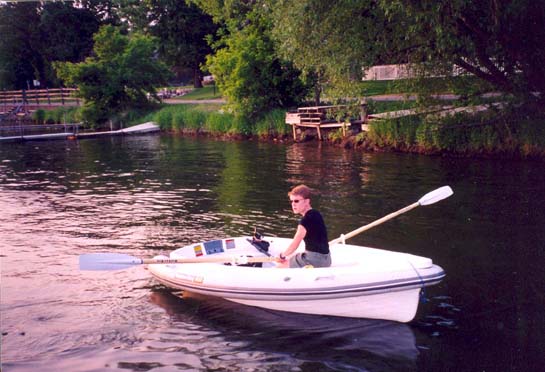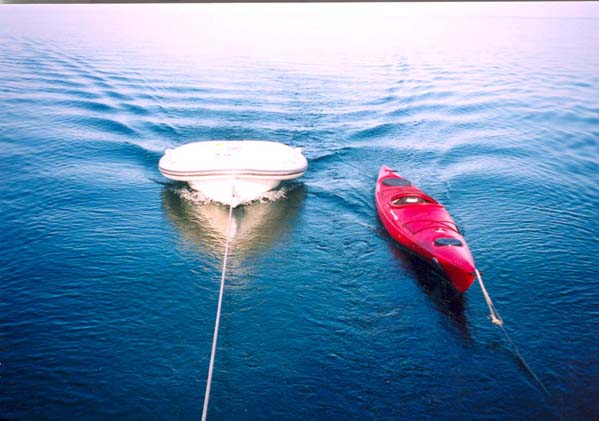 |
| Michele Pufahl rowing the Walker Bay 10 RID |
Revisiting The
Walker Bay 10
The Changes Are Impressive
By Captain Thom Burns
Back in the June of 2002 issue, some Northern Breezes Sailing School instructors and I reviewed the Walker Bay 10. We liked how it rowed. We liked how it towed and it was reasonably manageable to move around on land with the built in keel wheel. None of us liked it much as a sailboat because it was easy to slide around if the floor got wet, the main sheeted in the middle of the boom which greatly lessened the area available to move from side to side, and the tiller telescoped but did not raise up for a quick duck under or behind the back transfer move.
Rigid Inflatable
The new Walker Bay 10 RID for rigid inflatable is the same boat with several
significant additions. The most important are the inflatable tubes that attach
to the sides of the dinghy via tracks using sewn in bolt ropes or equivalent.
After the tubes are on, they are inflated using a foot pump. The whole process
of assembling the Walker Bay 10 including the tubes but without the sail rig
took about 40 minutes. The second time around would be a little faster. These
tubes stabilize the dinghy to the point that I, at 170 lbs., can stand on the
edge without tipping the dinghy.
The next big addition to the boat is a non-skid floor. The floor keeps the boat
dry and it gives the rower a bracing pad. It also potentially keeps your
groceries dry.
The oars are light and of high quality with two locking positions. This boat
rows well even when loaded. It has good carrying capacity. The inflatable tubes
make it friendly to the mother ship when boarding and disembarking.
 |
| Michele Pufahl rowing the Walker Bay 10 RID |
How We Used It
We used it as our primary dinghy for our Islander 36. We never had a problem
towing it even in 4 - 5 ft. seas. I pulled a swimming kayaker right over the
rail and then her water logged kayak was rolled over the bow to drain it. The
point is that this boat is incredibly stable. So much so that in rougher water
we tied the 14 foot kayak upside down on the Walker Bay 10. The Walker Bay never
missed a beat, and I didnít have to bother hoisting a long kayak aboard.
I put a motor on it for a short period of time. It worked pretty well. If you
are by yourself, you may want to get a tiller handle extender for the outboard
so you can sit farther forward and reduce stern drag. The item is an accessory
on Walker Bayís website. I took the motor off for simplicity. Because it rows so
well, this was a good option for me.
So how do I like it as a sailing dinghy? It is much better than it was because
the floor keeps it dryer and it is far less slippery when wet due to the
non-skid floor. It is also much more stable with the tubes, and it doesnít heel
much even in a gust. It adds a little drag, but the stability is worth the drag
trade-off. The bottom line is that I would change the main sheet attachments to
the back of the boat and the end of the boom. This would open up the cockpit by
getting the mainsheet and hardware out of the center of the boat. This is how
the smaller dinghy kit sail plan is attached. Another answer is to shorten the
tiller by sliding it inside itself the extra space gained near the transom makes
it easier to pass the tiller behind the back as you transfer to the other side.
The larger the person the more awkward this maneuver is.
 |
Conclusions
The Walker Bay 10 is one of the better values in tenders you can buy. Especially
if you are going to tow it a lot and you appreciate the wonderful
characteristics of a rigid, hard dinghy and, now you get the stability of an
inflatable. Walker Bay has got this one right. Two of my dock neighbors went out
and bought them. Possibly the best news is that all you folks who have the older
Walker Bay eights and tens can retrofit them with a kit to a rigid inflatable
(RID).
Captain Thom Burns publishes Northern Breezes and Sailing Breezes.
For more info:
www.walkerbay.com
See June 2002 Review
The Walker Bay 10 RID tows well. Here the Cape Lookout kayak is just in front of the Walker. The Walker would handle the Cape Lookout upside down on top of it in bigger 3 - 4 foot waves.